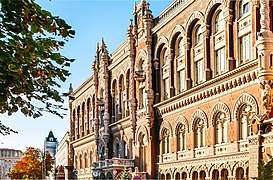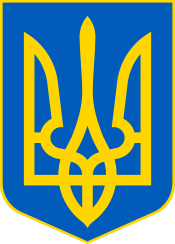National Bank of Ukraine
National Bank of Ukraine (Ukrainian: Національний банк України) or NBU (Ukrainian: НБУ) is the central bank of Ukraine – a government body responsible for unified state policy in the field of country's monetary circulation, including strengthening of national currency unit – hryvnia. It regulates and supervises activities, functions and legal status of government and commercial banks based on principles of the Constitution of Ukraine and the law of Ukraine "About the National Bank of Ukraine".
| |||
| Headquarters | 9, Instytutska st, Kiev, 01601 | ||
|---|---|---|---|
| Coordinates | 50°26′50″N 30°31′52″E | ||
| Established | 1991 | ||
| Ownership | 100% state ownership[1] | ||
| Governor | Kyrylo Shevchenko[2] | ||
| Central bank of | |||
| Currency | Hryvnia UAH (ISO 4217) | ||
| Reserves | USD 28.802 billion | ||
| Bank rate | 6.0% (from Jun 12, 2020)[3] UAH 20.20%, FE 4.80% (January 2019)[4] | ||
| Interest on reserves | UAH 13.0%, FE 2.60% (January 2019) | ||
| Website | www.bank.gov.ua | ||
History

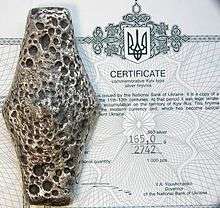
Banking in Ukraine traces its history back to 1918 when on December 22, 1917, the Central Council of Ukraine adopted a law "On transformation of the Kiev office of the Russian State Bank into the Ukrainian State Bank". The law united all offices of the former State bank, Noble Land Bank, and Peasant Land Bank. At the same time there existed a decree of the Central Executive Committee of Ukraine about the nationalization of banks since December 14, 1917. On January 5, 1918, the Ukrainian State Bank started to issue its own money. On August 10, 1918, there was signed a statute on the Ukrainian State Bank. On August 23, 1918, there was established the State Land Bank.
At the end of World War I, Ukraine became occupied by a new Russian regime – Bolsheviks. Bolshevist Russia adopted a law of War Communism which discontinued use of any financial institutions. However, in 1921 across Ukraine started to be established State Banks of the Russian SFSR which later were transformed into the Central Bank of the USSR.
Before the fall of the Soviet Union during the times of Period of reconstruction, the National Bank of Ukraine was a republican branch of the Central Bank of the USSR, while there were registered number of banks with various status. There were over 15 banks of ministerial status, over 20 banks of state/cooperative institutions, Moscow banks in Ukraine, banks with state status. Officially, the National Bank of Ukraine acted as the Central Bank of Ukraine since early 1991. Like institutions of many newly independent nations, it faced dire financial straits during the 1990s, leading to a prolonged period of hyperinflation.
On March 20, 1991, the Verkhovna Rada (parliament) of Ukraine adopted the resolution "On Banks and Banking Activity", which became Law on May 1. The resolution declared ownership by the Ukrainian SSR of the Ukrainian Republican Bank of the State Bank of the USSR (later National Bank of Ukraine), the Ukrainian Republican Bank of the State Commercial Industrial-Constructional Bank of the USSR "Ukrprombudbank", the Ukrainian Republican Bank of the Savings Bank of the USSR, and the Ukrainian Republican Bank of the ForeignEconomBank of the USSR as well as the Ukrainian Republican Department of Encashment of the State Bank of the USSR.
Former President of Ukraine Viktor Yushchenko was Governor of the National Bank of Ukraine from January 1993 to December 1999, before becoming Prime Minister. Later Serhii Arbuzov became Prime Minister of Ukraine for a short term in 2014 after being Governor of the National Bank.
Legal status and structure
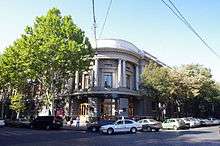
The legal status of the National Bank of Ukraine and the principles of its organization and activities are determined by the Constitution of Ukraine and the Law of Ukraine "On the National Bank of Ukraine".[5]
The National Bank of Ukraine is a legal entity with separated property, which is the object of the state property. Its authorized capital amounts to UAH 100 million and is the state-owned property which is in the full economic competence of the National Bank.[6]
According to Article 99 of the Constitution of Ukraine, adopted in 1996, the main function of the country's central bank is to ensure stability of monetary unit – the Hryvnia. To carry out its main function, the National Bank shall foster the stability of the banking system and, within its competence, the price stability.
According to the Law of Ukraine "On the National Bank of Ukraine", the National Bank is the central bank of Ukraine, a specific central body of the state administration, its issuing center which pursue common state policy in money circulation, credit, strengthening of monetary unit; it coordinates functioning of the banking system in general; determines exchange rate of the monetary unit against foreign currencies. The National Bank determines a kind of bank notes, their denomination, distinctive features and their protection system. The National Bank of Ukraine ensures the accumulation and custody of the gold and currency reserves and the conduction of transactions with them and the banking metals. The National Bank of Ukraine sets up the order of determining a discount rate and other interest rates; it gives permission for commercial banks' registration and licenses banking business; determines the standard of emergency funds for commercial banks and other financial and credit institutions.
The National Bank of Ukraine has the power to initiate legislation.[7] Resolutions of the NBU becoming valid just by publishing on their homepage www.bank.gov.ua. Decisions of the NBU may be just appealed at court due to Art.74 of the Law about the National Bank,[8] however, courts may not suspend resolutions during the investigation of appeals, just by court sentences.
The National Bank of Ukraine is governed by the Head of the National Bank of Ukraine and its directory, while its functions are coordinated by the Council of the National Bank of Ukraine. The council consists of 15 members including the Head of the National Bank as the ex officio position. The other members of the council are appointed by an equal quota of seven members from the President of Ukraine and the Verkhovna Rada.
Functions
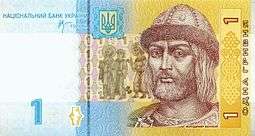
According to the Constitution of Ukraine, the main function of the National Bank is to ensure the stability of Ukraine's monetary unit. To carry this out, the National Bank fosters the stability of the banking system and, within its competence, price stability.
Due to Art.51 of the law about the National Bank of Ukraine, the NBU is accountable for its activities to the Verkhovna Rada of Ukraine, the President of Ukraine and the Cabinet of Ministers of Ukraine[8]
The National Bank also carries out the following functions:
- to determine and pursue the monetary policy in accordance with the General Principles of the Monetary Policy developed by the Council of the National Bank of Ukraine;
- to issue the national currency of Ukraine on a monopoly basis and to organize its circulation;
- to establish the rules of conducting banking transactions, accounting and reporting, protection of the information, funds and property for the banks and other financial and credit institutions;
- to organize and to provide the methodological support to the system of the monetary, crediting and banking statistical information and the statistics of the balance of payments;
- to determine the areas of the development of modern electronic banking technologies, to establish, co-ordinate and control the creation of electronic means of payment, payment system, banking automation and the banking information protection facilities;
- to exercise the banking regulation and supervision;
- to keep a Register of banks, their branch and representative offices, currency exchanges and financial and credit institutions, to license banking business and transactions, if provided for by the laws;.
- to compile, analyze and forecast the balance of payments;
- to represent Ukraine's interests in central banks of other states, international banks and other crediting institutions, where the cooperation takes place at the level of central banks;
- to exercise the currency regulation with the competence to be defined by a special law, to determine the procedure of effecting payments in the foreign currency, to organise and exercise the currency control over the commercial banks and other credit institutions which are in possession of a National Bank's license for the transactions with currency values;
- to ensure the accumulation and custody of the gold and currency reserves and the conduction of transactions with them and the banking metals;
- to analyze the status of the monetary, crediting, financial, pricing and currency relations;
- to organize the collection and transportation of bank notes, coins and other values;
- to implement the national policy of the protection of state secrets within the system of the National Bank;
- to take part in the training of personnel for Ukraine's banking system;
- to exercise other functions in the monetary and crediting sphere within its competence defined by the law.
Governors of the National Bank of Ukraine
Since the bank's establishment, the following statesmen were the Governors of the National Bank of Ukraine (initially the title of the position was the Chairman of the Board of the National Bank of Ukraine)
| No. | Portrait | Name | Took Office | Left Office |
|---|---|---|---|---|
| 1 |  |
Volodymyr Matvienko | 1991 | 1992 |
| 2 | Vadym Hetman | 1992 | 1992 | |
| 3 |  |
Viktor Yushchenko | 1993 | 2000 |
| 4 | .jpg) |
Volodymyr Stelmakh | 2000 | 2004 |
| 5 | 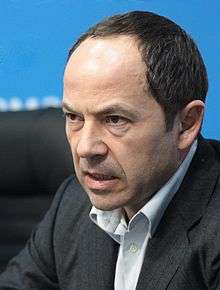 |
Sergiy Tigipko | 2002 | 2004 |
| 6 | .jpg) |
Volodymyr Stelmakh | 2004 | 2010 |
| 7 |  |
Serhiy Arbuzov | 2010 | 2012 |
| 8 | Ihor Sorkin | 2013 | 2014 | |
| 9 |  |
Stepan Kubiv | 2014[9][10] | 2014[11] |
| 10 | 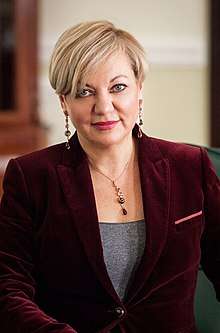 |
Valeriya Hontareva | 2014[11][12] | 2017[13] On 11 May 2017 the bank installed deputy governor Yakiv Smoliy as acting governor.[14] |
| 11 | 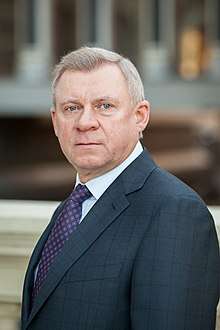 |
Yakiv Smoliy | 2018[15] | 2020[16] On 3 July 2020 First Deputy Governor Kateryna Rozhkova temporarily assumed Smoliy's duties.[17] |
| 12 |  |
Kyrylo Shevchenko | 2020[2] | Incumbent |
Council of the National Bank of Ukraine
On 25 October 2016 ex-Minister of Economy Bohdan Danylyshyn was appointed Head of the Council of the National Bank of Ukraine.[18] Economist Tymofiy Mylovanov became his Deputy Head.[18]
A Council's meeting is valid if at least six members are present.[19]
Banking sector
Due to the recent economic crisis, the number of the registered banks decreased sharply to 108 in 2016.[20] The National Bank of Ukraine announced a target of approximately 80–100 banks at the market.
There are state-owned banks like Oshadny, Ukrexim or Ukrgas, but the vast majority of banks is in private property. Largest banks by assets are the Privatbank (PrivatGroup) and the state savings "Oshadnybank". All registered banks are member of the Deposit Guarantee Funds, which guarantees deposits up to 200.000 UAH per person and bank in case of insolvency. The Oshadnybank is excluded from this fund because Ukraine guarantees their deposits directly.
Banks are divided by the National Bank into four categories depending on their capitals (for intensity of banking supervision).[21] There are a couple of big banks owned through off-shore companies. However, since 2016 all bank owner-structures had to be published till the last physical person to the National Bank of Ukraine to enforce the Anti-money-laundering and -tax-evasion-policy of the NBU. Foreign banking is still dominated from the Russian Federation (Sberbank, VTB, Alfa, Prominvest), while the Austrian Raiffeisen Aval Bank continues to stay strong. Per 01.04.2016 private households are holding f.e. 375,2 Mrd.UAH deposits in Ukrainian banks[20]
Commemorative coins
The national Bank of Ukraine offers a broad scale of commemorative and bullion coins and numismatic products, which are being sold primarily (2/3 of production) by the branches of NBU and 1/3 by state banks (Oshadnybank and Ukrgasbank).[22][23]
See also
- National Bank of Ukraine building
- Ministry of Finance (Ukraine)
References
- https://d-nb.info/1138787981/34
- Ukraine's parliament backs appointment of Kyrylo Shevchenko as NBU governor, UNIAN (16 July 2020
- http://www.fin.org.ua/news/1372364
- "National Bank of Ukraine Official Website. Cost of term deposits". 24 January 2019. Archived from the original on 8 March 2017.
- Reporting 01.04.2016 NBU
- Rada Approves Cancellation Of Rule That Bans Deputies From Switching Factions Archived 2010-10-09 at the Wayback Machine, The Financial (October 8, 2010)
- "Archived copy". Archived from the original on 2016-09-20. Retrieved 2016-05-26.CS1 maint: archived copy as title (link)
- Ukraine's parliament appoints new central bank chief Archived 2014-02-28 at the Wayback Machine, Reuters (24 February 2014)
- (in Ukrainian) MPs changed the head of the National Bank Archived 2014-03-13 at the Wayback Machine, Ukrayinska Pravda (24 February 2014)
- Ukraine crisis: EU deal to be signed on 27 June Archived 2014-06-19 at the Wayback Machine, BBC News (19 June 2014)
- Ukraine president gets parliament boost for peace plan Archived 2014-06-20 at the Wayback Machine, AFP news agency (19 June 2014)
- Williams, Matthias; Polityuk, Pavel; Rao, Sujata (10 April 2017). "After praise and death threats, Ukraine's central bank governor quits". Reuters. Archived from the original on 10 April 2017. Retrieved 10 April 2017.
- Williams, Matthias (10 May 2017). "Ukraine central bank post in political limbo as Gontareva leaves". Reuters. Retrieved 11 May 2017.
- http://en.interfax.com.ua/news/economic/492110.html
- Ukraine's parliament backs chief banker's exit, UNIAN (3 July 2020)
- Rozhkova takes office as acting Governor of NBU, Interfax-Ukraine (3 July 2020)
- NBU Council appoints Danylyshyn its head Archived 2016-10-26 at the Wayback Machine, UNIAN (25 October 2016)
- Danylyshyn heads NBU Council Archived 2016-10-26 at the Wayback Machine, Interfax-Ukraine (25 October 2016)
- "Статистика — ФГВФО". www.fg.gov.ua. Archived from the original on 2016-05-20.
- "ipLex - законодавство України". zakon.nau.ua. Archived from the original on 2013-11-03. Retrieved 2013-09-10.
- "Banknotes and Coins". www.bank.gov.ua. Archived from the original on 2016-05-06. Retrieved 2016-05-26.
- "National Bank of Ukraine issues commemorative coin". Cistran Finance. 21 October 2013. Archived from the original on 29 October 2013. Retrieved 25 October 2013.
Sources
- (in Ukrainian) Про банки і банківську діяльність. Law of Ukraine. March 20, 1991.
- (in Ukrainian) Про банки і банківську діяльність. Law of Ukraine. Accessed on August 17, 2006.
- (in Ukrainian) Про Національний банк України. Law of Ukraine. Accessed on August 17, 2006.
External links
| Wikimedia Commons has media related to National Bank of Ukraine. |
- Official website (in Ukrainian and English)
- Вся правда про фінансову систему СРСР (Ч.4 Перебудова) (All truth about financial system of the USSR (P.4: Perestroika))
- Melnyk, P., Tarahul, L., Hordei, O. Banking system of Russia. Banking systems of foreign countries (handbook). 2010.
- Kostyuchenko, O. Creation and evolution of banking in Ukraine. Banking Law. 2011.
